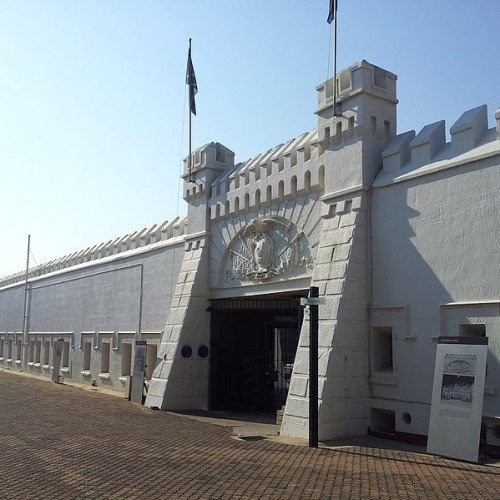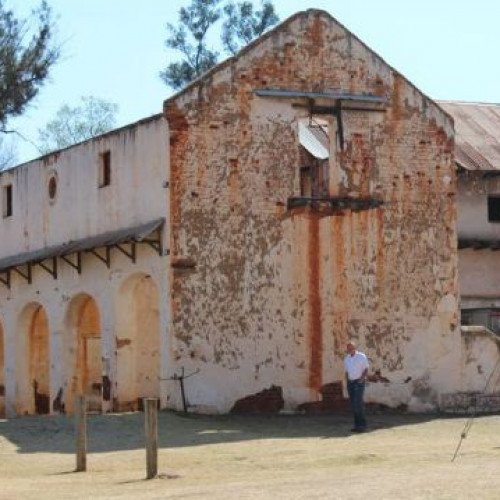Castles of "South Africa" CONSTITUTION HILL vs SAMMY MARKS

CONSTITUTION HILL
The Constitution Hill precinct is located at 11 Kotze Street in Braamfontein, Johannesburg near the western end of the suburb of Hillbrow. Constitution Hill is the seat of the Constitutional Court of South Africa. The hill was formerly the site of a fort which was later used as a prison. The Old Fort Prison complex is known as Number Four. The original prison was built to house white male prisoners in 1892. The Old Fort was built around this prison by Paul Kruger from 1896 to 1899 to protect the South African Republic from the threat of British invasion. Later, Boer military leaders of the Anglo-Boer War were imprisoned here by the British. The Old Fort prison was later extended to include "native" cells, called Section 4 and Section 5, and, in 1907, a women's section was added, the Women's Gaol. An awaiting-trial block was constructed in the 1920s. Both political activists opposed to apartheid and common criminals were held at the prison, and striking white mineworkers in 1907, 1913 and 1922. During the apartheid era the prison complex became a detention centre for political dissidents opposed to apartheid, striking white mineworkers (in 1907, 1913 and 1922), those deemed "anti-establishment" and those who simply violated the pass laws of the time. Mahatma Gandhi was imprisoned here in 1906. Nelson Mandela, Joe Slovo, Bram Fischer, Albert Lutuli and Robert Sobukwe are some of its famous prisoners. For this reason it was also called ''The Robben Island of Johannesburg'' due to how infamous it became as a result of holding these political prisoners. The site housed prisoners until 1983, when it was closed. Activists were usually held as awaiting trial prisoners and then sent off to Robben Island or Pretoria to serve jail terms. Brewing beer – an illegal activity if you were black – also landed many women in jail, a situation depicted in the Women Gaol. Still others were arrested for having sex across the colour bar or for homosexual sex. Amongst the practices reported during detention, the humiliating "Tauza" dance, the beatings in the notorious Number Four prison for black men, the detention for months in dirty, overcrowded conditions in the Awaiting Trial Block, or being stripped of their underclothes and their dignity in the Women's Gaol.
Statistics for this Xoptio

SAMMY MARKS
Samuel Marks (11 July 1844 – 18 February 1920) was a Lithuanian-born South African industrialist and financier. Born the son of a Jewish tailor in 1844 in Neustadt, Russian Empire, Marks was endowed with integrity, courage, astonishing business acumen and immense vitality. He accompanied some horses to Sheffield in England while still a youth and, not wanting to return to the Jewish persecution in Russia, decided to stay on. It was in Sheffield that he met his future in-laws. Hearing news of the diamond discoveries in Kimberley, he arrived at the Cape in 1869 and was shortly followed by his cousin Isaac Lewis, also from Neustadt-Sugind, with whom he forged the enduring partnership of Lewis & Marks. Marks started his career as a peddler in the rural districts of the Cape, but soon headed for Kimberley where his rise to prosperity began. They made a modest living supplying goods to mines and diggers, and later branched into diamond trading. Moving to Pretoria in 1881 he gained the confidence of President Kruger and the government of the Zuid-Afrikaansche Republiek (ZAR). His friendship with Kruger became close and enduring and they had in common humble origins and a ready wit. Marks advised that Kruger build a railway line from Pretoria to Lourenço Marques. With the discovery of gold in the boomtown of Barberton and later on the Witwatersrand, Marks acquired business interests in both places, but found the coalfields of the southern Transvaal and northern Free State to be a more lucrative prospect. The Zuid-Afrikaansche en Oranje Vrijstaatsche Mineralen en Mijnbouwvereeniging was founded in 1892 to mine these coal deposits, and later gave the town of Vereeniging its name. Lewis & Marks business interests included a distillery, a canning factory and a glass factory. Their firm opened collieries at Viljoensdrif and elsewhere, and also started Vereeniging Estates Ltd., which was dedicated to developing agricultural land along the Vaal River. Marks pioneered the use of steam tractors and progressive farming implements. He also sponsored the establishing of flour-mills and brick and tile works at Vereeniging. In 1910 Marks was nominated as senator in the first Union Parliament, an office he held until his death. When A.H. Nellmapius was unable to execute a manufacturing contract he had concluded with the Government due to lack of funds, Lewis & Marks took over and constructed the Eerste Fabrieken near Pretoria. Marks contributed generously to Jewish communities all over South Africa. The Pretoria synagogue was built in 1898, for which he donated all the bricks and paid for the electric light installation and chandeliers. At the end of the Anglo-Boer War, he presented a cast-iron fountain to the city of Pretoria, shipped from Glasgow and very Edwardian in design, it stands at the Zoological Gardens in Pretoria. Marks commissioned the statue of Kruger on Church Square in Pretoria – sculpted by Anton van Wouw and cast in bronze in Europe, it carried a price tag of £10,000.